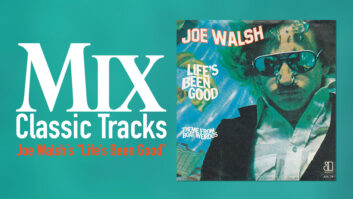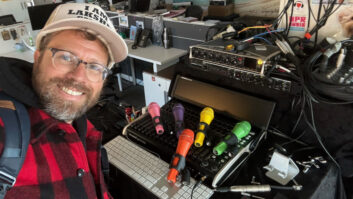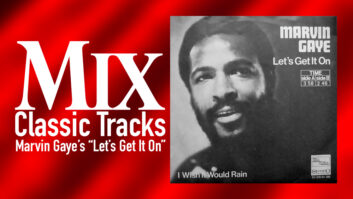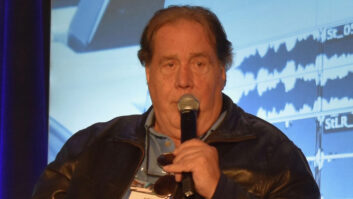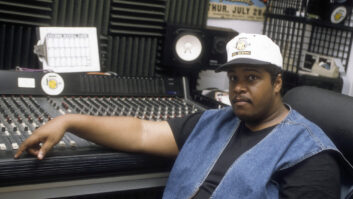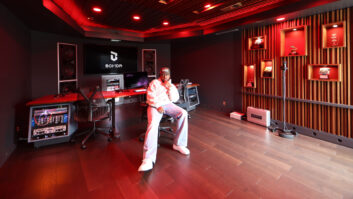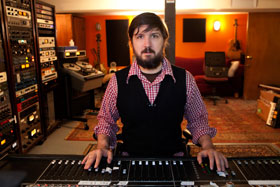
Photo: Vivian Johnson
Over the past 15 years, Tucker Martine has slowly but surely built a reputation as one of the most interesting and inventive producer/engineers in music—one who seeks out adventurous and innovative artists, loves to experiment in the studio with electronics and unusual sonic textures, and works easily in a wide variety of musical styles. His extensive credit list is littered with spectacularly idiosyncratic talents.
Based in Seattle from the mid-’90s until 2006, he worked on many albums with Wayne Horvitz—who had been a key driver in New York’s free-ranging, experimental “Downtown scene” before relocating to the Northwest—as well as with the always intriguing guitarist Bill Frisell (another N.Y.-to-Seattle transplant), violin phenom Eyvind Kang, saxophonist John Zorn, Mudhoney and many others.
In 2006 he worked for the first time with the famously eclectic Portland band The Decemberists (on The Crane Wife), and ended up liking Portland so much that he moved there and, as he had in Seattle, built his own home studio. He’s worked on every Decemberists album since, and toiled on an impressive array of projects—sometimes producing, tracking and mixing, other times just mixing—including Mudhoney’s Lucky Ones, solo albums by The Decemberists’ Colin Meloy and Death Cab for Cutie’s Chris Walla, My Morning Jacket’s extraordinary Circuital, Bill Frisell’s live masterpiece East/West, preliminary recording for REM’s Collapse Into Now, violinist extraordinaire Jenny Scheinman’s wonderful Mischief and Mayhem, and two superb discs five years apart from Floratone—an occasional quartet comprising Frisell, drummer Matt Chamberlain, Martine and co-producer Lee Townsend.
A native of Nashville, where his father, Layng Martine Jr., has been a successful songwriter for several decades, Tucker played drums in high school but also gravitated to the sound side and was soon recording the groups he was in and then others. Early on he was influenced by Brian Eno and Daniel Lanois “because they were using the studio as an instrument and were making some music that was constructed not only entirely in the studio, but because of the studio. I was fascinated with that—tape loops and tape manipulations and processing. I also loved abstract sounds and manipulating things and atmospheres.” After spending some time in Boulder, Colo., playing music with his brother, he traveled around the U.S. for a few months before ending up in Seattle, in 1990, right as Nirvana and the grunge scene were exploding.
Is Seattle where you hooked up with Wayne Horvitz?
Yes. Wayne was there and Bill Frisell had just moved there, so that was a draw, aside from the fact that the Subpop scene was exploding and whatnot.
How, if at all, did that affect your aesthetic?
It wasn’t something I was deep into, although seeing Nirvana was irresistible, and I eventually got into Soundgarden as well. But I was really looking for outlets to experiment with a studio and with songs that could be informed more by the studio, rather than that music, which was about capturing that intense live energy.

Wayne Horvitz’s 4 + 1 Ensemble: From a Window (Avant Records, 2002)
I imagine Seattle was a good place to be poor in those days.
It was, and I landed a pretty decent job bartending and I met a lot of folks that way.
What was it about Wayne Horvitz that appealed to you?
Well, I knew Wayne had been a big part of the Downtown Scene and was part of Naked City, which was a project of John Zorn’s, and also Wayne was starting to produce records more. A friend of mine who had a studio in Seattle told me Wayne was going to do a project there, so I offered to be an assistant, which I’d never done—I’d really just recorded people at home, pretty much, on my 4-track and my 8-track. So I was kind of a gofer on that. Wayne and I hit it off and I helped him put together his home studio and then Bill Frisell wanted to record a project there, so I engineered that.
So as you were getting established in Seattle, did the word spread about your skills? And how did you build your first studio?
As soon as I got to Seattle and got that bartending job, I started saving every dollar I could and started buying little pieces. I bought a half-inch Otari MX5050 8-track machine, and I literally had a jar that I was saving money up for buying a Mackie [console]. They had just been announced but weren’t available yet. I was messing around on my own and recording friends, and every once in a while one of them would turn out okay and they’d tell their friends and they’d call me. So I’d buy one more SM57 or a 421.
Each of those people had friends, and I was meeting people going out to shows and what have you, and I was basically working for nothing for a while because I was trying to learn and get experience. I was much more interested in figuring out how to make something great than I was in making money.
What was your studio like?
It was in my house, in my basement. I’ve had a number of basement studios. [Laughs] Eventually I got up the nerve to start asking for $5 an hour, then $7. All these things were happening simultaneously. I got to record things for Bill Frisell, and Wayne Horvitz started a band where he wanted me to do live processing for what was essentially this chamber group of his.
Is that the 4 Plus One ensemble?
Yes. I was the “Plus One.” [Laughs]

What did “processing” mean in the context of a live group?
In that era, which is pre Boss looping pedals and all that, the Lexicon Jam Man had just come out, so I had two of those and you could do live on-the-fly sampling with those—catch a phrase and trigger it, or even play it backwards, or you could make loops, so I used those a lot and I had a ring modulator and tape delays and reverb units. Sometimes I would take a phrase that someone would play and I would mangle it some way and reintroduce just the return from a cavernous reverb or something.
Did you end up getting a Mackie console?
I did. It was 24×8. I was so happy!
That changed a lot of people’s lives, along with the MDMs of that era: the ADAT and the DA-88. They helped democratize recording. It sounds like you were on that road already.
I was on that road already, but I can’t imagine what would have happened if that hadn’t come along, or something hadn’t come along at that price point. I might have thought I was priced out of that business, because I took a pretty thin resume to all the studios in Seattle—I was ready to take out the garbage and stuff, but no one was calling me back, so I thought, “That route’s not going to work. I just need to learn by doing it.” I’ll read stuff and any time I can ask questions of somebody I’ll do that. I tried a million things and made a bunch of mistakes and made some bad-sounding recordings, but eventually I got better at it.
How long did you stay in that spot?
I was in a house for one year when I first moved to Seattle, and then I moved to the first place I dubbed Flora, because it was on Flora Avenue, and I was there for 11 years. [His Portland studio is also called Flora.]
Did you feel limited by your basement studio?
No, but I was always eager and excited to work in better studios, too. I think that’s one of the reasons I hung on and worked for Wayne Horvitz for a number of years—because he was involved with quite a few projects that had enough budget to go to “real” studios. That gave me more experience and more confidence, and it informed what I did at home.
When people come to you, I assume a lot of them know your predilection to electronics and doing interesting textural things. How often do people want that from you, vs. wanting a straight documentary thing?
It depends. Although I’ve certainly put my aesthetic on some of the higher-profile things I’ve done—like My Morning Jacket and, to some extent, The Decemberists—in truth I’m usually just trying really hard to make it sound like the band and to make it sound really good. I’m not sitting there thinking, “I haven’t gotten any of my trickery on here yet!” There’s trickery in making things sound like they haven’t been futzed with a lot, too.
More often than not people aren’t explicitly asking for that, but I feel very fortunate that I tend to attract people that are excited to try different things and willing to take some risks.

Tell me about working with My Morning Jacket.
It was interesting because initially I was invited to come help them record demos, although I think they knew they might want to use some of it later. I think on their previous record, the process had become a little studio-intensive and construction-like, yet they’re known as this really great live band. As people often do, they will react against whatever they’ve done last, so I think they wanted to go really live and organic.
“So, we’ll cut it live with plenty of bleed.”
[Laughs] That’s what we did, in this huge open church in Louisville that had the acoustics of a gymnasium.
What did you bring in there?
Jim [James, the group’s visionary singer and songwriter] has acquired a decent amount of gear, and their friend—who also became my friend—Kevin Ratterman, has a studio in his parents’ funeral home in Louisville, so he was roped in to help out, too. Then we found a Mackie on Craigslist for monitoring, and Jim has a Studer 827 24-track and the same monitors I tend to use, which are the ProAc Studio 100s; they’re not too flattering, so they make you work, but they’re not too fatiguing. Jim had a small collection of mics, as did Kevin, and I brought some things to fill in the gaps—some ribbon mics. I brought a Royer stereo SF 12 we used to capture the room sound, and during the sessions Jim bought an RCA 44 and Carl [Broemel] the guitar player, had an RCA 77 his dad owned, and we ended up using it for about half the vocals.
Interesting vocal choice…
I know. Jim was really excited about singing into it. I think he’s seen some footage or heard some great old recordings from way back when they’d used that.
There wasn’t a computer in the room and everything was bleeding into everything and we really didn’t know what kind of sounds we had on tape.
The gear was on the stage and there was a velvet curtain between me and the band. But we’re talking about a loud rock band in a gymnasium, so it was just a gesture to reduce the highs by a few dBs. Even then, when we were playing it back, it was in this very cavernous space and you could sort of get the idea, but you didn’t really know, which is why we chose to go to a very controlled environment to mix, a place that was acoustically dialed in. We ended up mixing at Blackbird [in Nashville], which was the opposite extreme.
When you work with a group over a few albums, as you have with The Decemberists, you must develop an intuitive sense of what they like and what they don’t like, what you can try and what you shouldn’t try. I think of them as being pretty experimentally minded.
I think that’s true. The last record I did with them, The King Is Dead, we’d done so much together by that point that the lines of communication were wide open and we really had a common vocabulary. Colin [Meloy] does a lot of experimenting in the songwriting process. It’s always different with everybody, and even record-to-record with a band like that. The concept album [The Hazards of Love] required a lot of experimentation to make things work because here were all these songs that had to go together and literally blend into each other. So you start a long series of experiments figuring out how to make it sound like they were always meant to be together. He wrote everything to be together, but we had to really figure it out: “All right, let’s get 10 people with floor toms in the room and we’ll put a mic on the other side of the room and crush it [with a compressor] and right on the last down beat it’ll ring out and go into the next song.” Those guys are as game to experiment sonically as anybody.

Floratone, clockwise from top left: Bill Frisell, Lee Townsend, Matt Chamberlain, and Tucker Martine.
Photo: Michael Wilson
Let’s end with Floratone. How do those albums come about? Obviously, you’re all busy doing other things. And how do you have two producers—you and Lee Townsend?
Matt [Chamberlain] was living in Seattle and I was getting to know him a bit and I roped him into a couple of things. I was such a fan of his playing and I knew he was a fan of Bill [Frisell’s], and I thought it would be cool to hear them together. Bill loved his playing, so it seemed like we were all sort of on the same page.
Bill was making a lot of sort of “documentarian” records—go in for three or four days with a group and document that. I was saying it would be fun to do a record that was a little more experimental in the studio. The premise is that we’re all making it together, and that will ensure that it doesn’t just fall into Bill writing some songs for us, which of course he could do. So Bill and Matt will improvise and I’ll record it and then Lee and I take everything and we go through it and we chop things up and move things around as needed. We also look for sections we can use without having to mess with them too much, but a lot of it is pretty cut-and-paste. So Lee and I will spend time doing that, and then Bill will write on top of those—like Eyvind Kang on viola and Ron Miles playing cornet and trumpet, so that gives it a more composed feeling. If you saw the sessions, it’s just thousands and thousands of slices.
I sometimes feel like when I hear it, it sounds like a nice tune by some great players and I think, “Man, did we take the hard way to get here, or what?” [Laughs] It’s weeks of chopping and editing. But it’s fun. Lee and I have a great time working together, and we have a lot of laughs. It’s a fun outlet for all of us and it can be whatever we want it to be.
Visit Tucker Martine’s Flora Recording and Playback in Portland, Ore., at www.florarecording.com.
